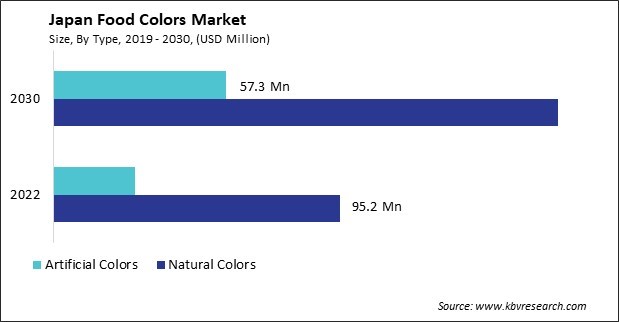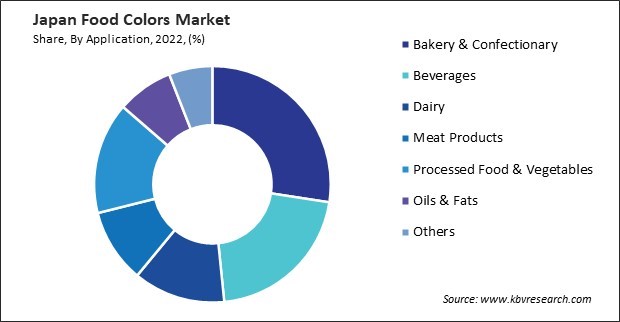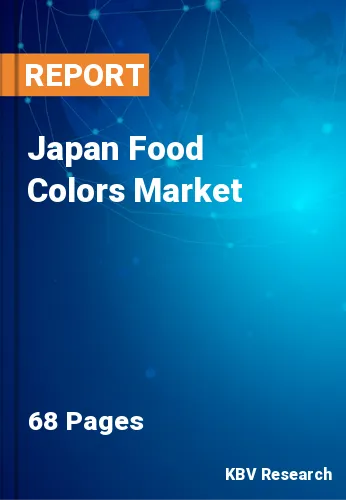The Japan Food Colors Market size is expected to reach $225.10 million by 2030, rising at a market growth of 8.0% CAGR during the forecast period. In the year 2022, the market attained a volume of 687.78 Tonnes units, experiencing a growth of 8.4% (2019-2022).
The food colors market in Japan is a dynamic and evolving sector that reflects the country's rich culinary traditions and innovative food industry. The food processing industry in Japan is pivotal in the dynamic food colors market. Renowned for its precision and commitment to quality, Japanese food processors incorporate innovative coloring agents to enhance visual appeal. The industry thrives on balancing traditional preferences and modern trends, with a growing demand for natural and organic alternatives.

The COVID-19 pandemic has also influenced the distribution channels of food color products in Japan. With lockdowns and restrictions affecting traditional retail channels, there has been a surge in online shopping for food ingredients, including food colors. Government regulations ensure the safety and authenticity of food colors market, fostering consumer trust. Japanese consumers appreciate vibrant and visually appealing food products, influencing manufacturers to invest in advanced coloring technologies.
According to the U.S. Department of Agriculture, in 2020, Japan's food processing industry successfully produced food and beverage products amounting to $218.3 billion. The COVID-19 pandemic has notably fueled a sustained upward trajectory in the consumption of frozen food over the past decade. Specifically, the frozen food industry witnessed a significant increase, rising from $5.56 billion in 2010 to $6.57 billion in 2020. These trends highlight the evolving preferences and behaviors in the Japanese food and beverage sector. In connection with this, the adoption of food and beverages in the food colors market in Japan reflects the dynamic shifts in consumer choices and industry trends within the country.
Japan has witnessed a significant surge in disposable income, particularly impacting the food colors market. The nation's economic landscape has transformed, with rising incomes leading to consumer behavior and preferences shifts, especially within the food industry. As disposable income increases, Japanese consumers increasingly favor premium and aesthetically appealing food products. This trend has significantly influenced the demand for food colors as consumers seek visually enticing culinary experiences.
Japan's vibrant and diverse food culture, coupled with a strong emphasis on presentation, has driven the adoption of food colors across a wide range of products. One notable aspect of the rising disposable income is the willingness of consumers to experiment with novel and exotic food options. This has created a burgeoning industry for unique and visually appealing dishes, further fueling the demand for high-quality food colors. In Japan, where culinary aesthetics are deeply ingrained in the culture, the food colors market responds to the evolving preferences of a more discerning and adventurous consumer base.
The increased purchasing power has also led to a growing awareness of food products' health and wellness aspects. Japanese consumers are becoming more conscious of the ingredients used in their food, including the types of food colors employed. Thus, Japan's evolving economic landscape and increased consumer spending propel the food colors market toward premium, visually enticing options, with a parallel emphasis on health-conscious choices favoring natural and organic alternatives.
In Japan, the food colors market serves as a vital component in culinary practices and holds significant cultural importance. Japanese cuisine is renowned for its visual appeal, and the art of food presentation is deeply ingrained in the nation's culinary traditions. Traditional Japanese dishes often feature vibrant colors, symbolizing freshness, seasonality, and balance. For instance, using vivid greens in dishes like matcha-flavored desserts highlights the emphasis on natural ingredients and the integration of seasonal produce. Red and white colors, symbolizing joy and purity, are prominent in celebratory dishes such as osechi ryori, a traditional New Year's feast.
The cultural significance of food colors in Japan also extends to religious and ceremonial practices. Certain colors are associated with specific occasions and festivals, and their incorporation into dishes holds deep-rooted meaning. For example, cherry blossom or sakura-inspired pink hues are prevalent during the annual Hanami festival, embodying the transient beauty of nature.
Moreover, the Japanese appreciation for aesthetics extends to packaging and presentation, where food colors are crucial. Bento boxes, intricately arranged with an assortment of colorful ingredients, showcase the meticulous attention to detail and the desire to create an appealing visual experience. Hence, the use of food colors market in Japan is a dynamic fusion of culinary craftsmanship and cultural symbolism, enriching the dining experience with visual narratives that celebrate nature, seasonality, and tradition.

The food colors market in Japan is a vibrant and dynamic sector, shaped by the unique preferences of Japanese consumers, stringent regulations, and a rich culinary heritage. Several companies stand out as key players in this industry, providing a diverse range of food coloring solutions to meet the specific needs of the Japanese food and beverage industry. One of the major contributors to the food colors market in Japan is San-Ei Gen F.F.I., Inc. The company is renowned for its extensive portfolio of food colorants, including synthetic, natural, and caramel colors. San-Ei Gen F.F.I., Inc. caters to various applications, from traditional Japanese confections to modern packaged foods.
Dainippon Ink & Chemicals (DIC) Corporation is another significant Japanese food colors market player. DIC is a global leader in the production of colorants, and its presence extends across various industries, including food and beverages. The company emphasizes research and development to offer innovative and sustainable color solutions. In the Japanese context, DIC is pivotal in providing food colors that align with the country’s cultural and culinary preferences.
Sensient Technologies Corporation, a key player globally, is also actively involved in the Japanese food colors market. Sensient’s focus on natural colors solutions aligns well with Japanese consumers' inclination towards clean-label and natural products. The company's commitment to meeting local regulatory requirements while delivering visually appealing and authentic colors positions it as a significant contributor to the Japanese food and beverage industry.
Kalsec Japan Co., Ltd. is recognized for its expertise in natural ingredient solutions, including food colors. Specializing in extracts, colors, and flavors derived from botanical sources, Kalsec Japan addresses the growing demand for natural and plant-based alternatives in the Japanese industry. The company's dedication to sustainability and understanding local flavor preferences contribute to its prominence in the food colors segment.
Nippon Soda Co., Ltd. is a Japanese company that plays a crucial role in the food colors market. Nippon Soda provides various colors solutions, including synthetic and natural colors, catering to diverse applications in the food industry. The company's emphasis on quality control and compliance with Japanese regulations underscores its commitment to delivering safe and reliable food colors options. These companies operate in food colors market where the culinary landscape is diverse, ranging from traditional Japanese dishes to a growing interest in international cuisines.
By Type
By Application
Our team of dedicated experts can provide you with attractive expansion opportunities for your business.

